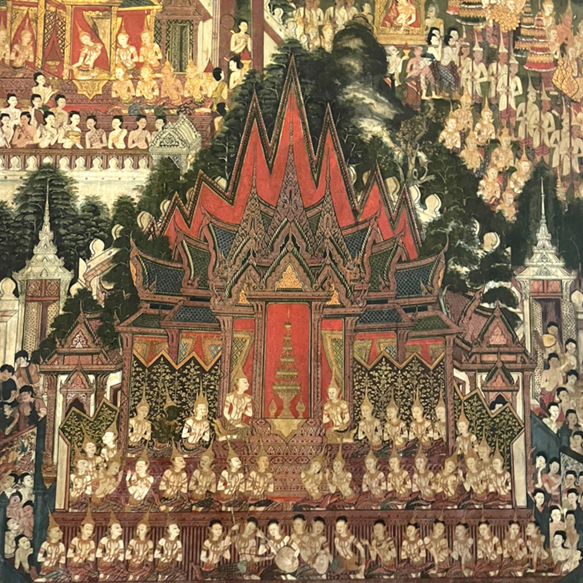Time and Space in Thai Mural Paintings: Case Studies of Phra Thinang Putthaisawan and the Ordination Hall of Wat Suthatthepwararam
DOI:
https://doi.org/10.69598/sbjfa262633Keywords:
Space and Time, Mural Painting, Multi-Dimensions on a Single PlaneAbstract
Humans live in a four-dimensional world of space and time. However, paintings are two-dimensional objects that create an illusion mimicking the three dimensions of space and the fourth dimension of time. Paintings in each culture have different ways of achieving this effect. This study aims to analyze the design process in Thai mural paintings that convey the three dimensions of space and the fourth dimension of time. The study approach examines the composition of murals and analyzes the architectural scenes in the early Rattanakosin period. The findings are distinctive characteristics of early Rattanakosin period mural paintings which could be categorized into four points: 1) Panel 1, Phrathinang Putthaisawan, was designed in three separate parts, each narrating a specific story or scene from the Buddha’s life. 2) The architectural design of this mural is a sectional view of the scene, where the front of the building is open, showcasing the people and activities inside. A traditional painting technique dating back to the Ayuthaya period. 3) A common technique used by craftsmen was to design the palace’s architectural scenes as “multi-dimensions on a single plane,” showing the angles of the palaces’ roofs by layering them and using “Oblique” lines on the extended wings of the building. 4) The mural paintings from Wat Suthat Thepwararam developed a three-dimensional style, emphasizing areas closer to reality and more complex. Meanwhile, the design of the palace scene also became more three-dimensional by using traditional techniques to add depth and clear oblique lines, resulting in a more complicated and detailed overall composition that can express time more precisely. This conclusion is consistent with the observations made by historians that the society during King Rama the Third’s reign had more diverse and bustling spaces filled with people and various activities.
Downloads
References
ค๊อกซ์, นีล. (2557). คิวบิสม์: Cubism. (วรเทพ อรรคบุตร และอณิมา ทัศจันทร์ แปล). เดอะเกรทไฟน์อาร์ท.
นิธิ เอียวศรีวงศ์. (2555). ปากไก่และใบเรือ. ฟ้าเดียวกัน.
พระมหาสุรพล ชิตญาโณ, พันธุ์ศักดิ์ จักกะพาก และ บรรจบ ไมตรีจิตต์. (2542). โบสถ์วัดโพธิ์. อมรินทร์พริ้นติ้งแอนด์พับลิชชิ่ง.
พีระพัฒน์ สำราญ. (2558). สถาปัตยกรรมวัดสุทัศนเทพวราราม (พระอุโบสถและสัตตมหาสถาน). ศูนย์ข้อมูลสถาปัตยกรรมไทย คณะสถาปัตยกรรมศาสตร์ มหาวิทยาลัยศิลปากร.
สน สีมาตรัง. (2522). สถาปัตยกรรมในจิตรกรรมฝาผนังสกุลช่างอยุธยาตอนปลาย. [สารนิพนธ์หลักสูตรประกาศนียบัตรชั้นสูง สถาปัตยกรรมไทย ไม่ได้ตีพิมพ์]. ภาควิชาศิลปสถาปัตยกรรม บัณฑิตวิทยาลัย มหาวิทยาลัยศิลปากร.
สุรศักดิ์ เจริญวงศ์. (2536). เอกสารการสัมมนาทางวิชาการ เรื่อง ขนบนิยมในการสร้างสรรค์และการนำเสนอจิตรกรรมไทยประเพณี. [เอกสารไม่ได้ตีพิมพ์]. คณะจิตรกรรม ประติมากรรมและภาพพิมพ์, มหาวิทยาลัยศิลปากร.
สำนักพิมพ์เมืองโบราณ. (2525). วัดช่องนนทรี. เมืองโบราณ.
Ackerman, J. S. (1991). Distance Points: Essay in Theory and Renaissance Art and Architecture. MIT Press.
Cox, N. (2014). Cubism. (W. Akkabootara & A. Tasajan Trans.). The Great Fine Arts. [in Thai]
Charoenwong, S. (1993). Academic Seminar Paper: Traditions in The Creation and Presentation of Thai Traditional Painting. [Unpublished Manuscript]. Faculty of Painting, Sculpture and Graphic Arts, Silpakorn University. [in Thai]
Chityano, S., Chakkapak, P & Maitreejit, B. (1999). The Ubosot of Wat Pho. Amarin Printing & Publishing. [in Thai]
Eoseewong, N. (2012). Pen and Sail: Literature and History in Early Bangkok. Sameskybooks. [in Thai]
Mung Boran Press. (1982). Wat Chong Nonsi. Mung Boran Press. [in Thai]
Phaidon Press Ltd. (2017). The Art Museum. Phaidon Press Ltd.
Pierpont Morgan Library. (1244-1254). MS M.638, fol 28v. [Manuscript]. https://www.themorgan.org/collection/crusader-bible/56
Samran, P. (2015). The Architectural Study of Wat Suthat Thepwararam. Thai Architecture Archive, Faculty of Architecture, Silpakorn University. [in Thai]
Simatrang, S. (1979). The Architecture in Thai Mural Painting of the Late Ayutthaya School. [A thesis for the certificate on Thai Architecture Unpublished Manuscript]. Department of Architectural Art, Graduate School, Silpakorn University. [in Thai]
The National Palace Museum. (1967). Chinese Cultural Art Treasures: National Palace Museum Illustrated Handbook. (4th ed.). The National Palace Museum.

Downloads
Published
How to Cite
Issue
Section
License
Copyright (c) 2023 © by the Author(s) & Silpa Bhirasri Journal of Fine Arts.

This work is licensed under a Creative Commons Attribution-NonCommercial-NoDerivatives 4.0 International License.
The journal's editorial team does not have to agree with the views and comments in the author's article, nor are they responsible for the comments.











